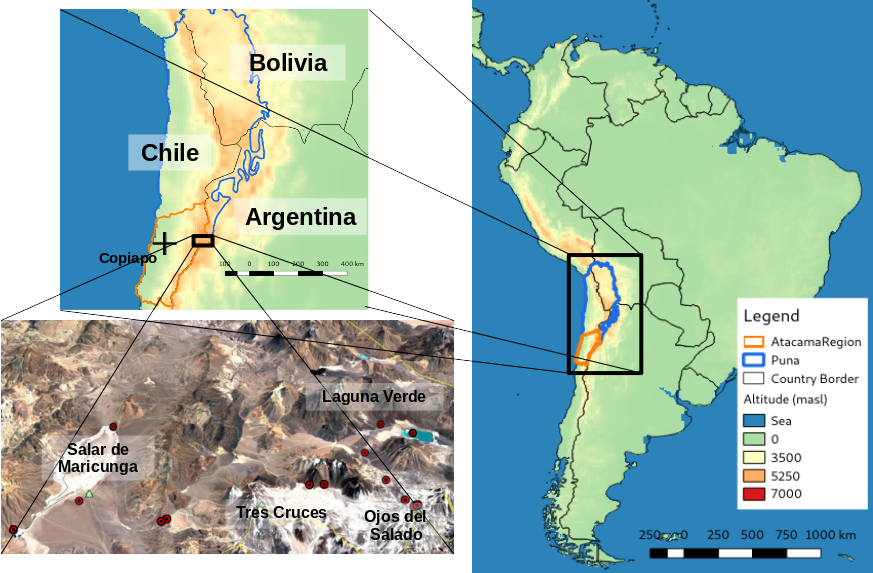Characterization of the Potential of the Puna de Atacama region in terms of Planetary Analogs : Preliminary results for the Salar de Maricunga, Tres Cruces, Laguna Verde and Ojos del Salado Areas
- 1Universidad de Atacama, IDICTEC, LICA, Chile (adrien.tavernier@postgrados.uda.cl)
- 2Universidad de Atacama, CRIDESAT, Chile
- 3Universidad de Atacama, CIC, Chile
- 4Technological University Dublin, TU Dublin, Ireland
- 5International Lunar Exploration Working Group, ILEWG EuroMoonMars
- 6Free University of Amsterdam, VUA, Netherlands
- 7Leiden University, Netherlands
The Atacama Desert and the Puna (an ecoregion of the Central Andes that mainly straddles three South American countries, Argentina, Bolivia and Chile, with altitudes ranging from 3500 to 4800 meters above sea level [masl] see. Figure 1) have extreme terrestrial environmental characteristics that make these two geographic locations potential analogs of the conditions that Mars may have experienced during its geological history [1,2].

Figure 1 : Geographical landmark / Bottom left, Zoom in on the campaign area with sampling points present (Copyright : Google Earth)
The University of Atacama (UDA) located in Copiapo (27º37S / 70º33W) in Chile, aims to conduct multidisciplinary studies to better characterize the extreme environment of the Puna de Atacama. This project is based, in particular, on the forthcoming implementation of a high-altitude laboratory located at 3800 masl in the vicinity of the Salar de Maricunga (26º92S / 69º08W) [3]. The construction of this high-altitude laboratory should enable the scientific exploration of the region to be strengthened. Moreover, in order to benefit from expertise in the field of planetary analogs, the UDA has approached the EuroMoonMars program [4], which has more than ten years of experience in organizing analog field campaigns. This partnership in the making has taken shape with the setting-up of a first joint expedition at the end of February/beginning of March 2021. This expedition was organized by the Cryosphere and Water laboratory of the UDA (LICA) and has also been supported remotely by members of the EuroMoonMars program. During this high-altitude 10-days campaign (between 3800 and 6500 masl) the geographical extend included the Salar de Maricunga (26º92S / 69º08W), the Tres Cruces (27º07S / 68º79W), the Laguna Verde (28º88S / 68º47W) and finally the Ojos del Salado areas (27º11S / 68º54W) (see. Figure 1), whose potential as a Martian analog has been highlighted in recent publications [5].
To the initial objectives related to environmental sciences, scientific, technical, logistical and medical protocols specific to planetary science and space exploration were added, as the first steps towards for the organization of more complex campaigns involving EuroMoonMars people in the field. According to the multidisciplinary perspective of characterizing the environment of the Puna de Atacama and in addition to geophysical work, soil, water and biological material sampling was carried out along an altitudinal gradient (see. Figure 1).
This study aims to review the preliminary results of these samples, notably via the geochemical analysis of the soils (carried out using Inductively Couple Plasma spectrometry (ICP) and X-fluorescence spectroscopy) contextualized in the perspective of considering the Puna de Atacama as a Martian analog.
Acknowledgments: The authors would like to thank the people involved in the success of this project, which aims to both promote and protect the incredible natural heritage of the Puna de Atacama region.
References: [1] Navarro-González, R. et al. (2003) Science, 302(5647), 1018-1021. [2] Schmidt, S. K. et al. Antonie van Leeuwenhoek, 111(8), 1389-1401. [3] Tavernier, A. et al. (2021) 52nd LPSC conference 15-19 March, 2021. LPI Contribution No. 2548, id.2253.[4] Foing, B. et al. (2020) p. EPSC2020-14. [5] Kereszturi, Á. et al. (2020) Astrobiology, 20(6),677-683.
How to cite: Tavernier, A., Garcia, A., Ulloa, C., Oses, R., Bonnail, E., McGrath, K., Mohan, C., Reilly, H., Brady, G., and Foing, B.: Characterization of the Potential of the Puna de Atacama region in terms of Planetary Analogs : Preliminary results for the Salar de Maricunga, Tres Cruces, Laguna Verde and Ojos del Salado Areas, European Planetary Science Congress 2021, online, 13–24 Sep 2021, EPSC2021-452, https://doi.org/10.5194/epsc2021-452, 2021.

